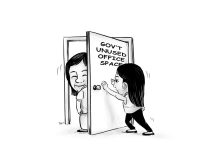[av_one_full first min_height=” vertical_alignment=” space=” custom_margin=” margin=’0px’ padding=’0px’ border=” border_color=” radius=’0px’ background_color=” src=” background_position=’top left’ background_repeat=’no-repeat’ animation=”]
[av_heading heading=’Our education system is still in crisis’ tag=’h3′ style=’blockquote modern-quote’ size=’30’ subheading_active=’subheading_below’ subheading_size=’18’ padding=’10’ color=” custom_font=” av-medium-font-size-title=” av-small-font-size-title=” av-mini-font-size-title=” av-medium-font-size=” av-small-font-size=” av-mini-font-size=” admin_preview_bg=”]
BY HERBERT VEGO
[/av_heading]
[av_textblock size=” font_color=” color=” av-medium-font-size=” av-small-font-size=” av-mini-font-size=” admin_preview_bg=”]
February 20, 2018
[/av_textblock]
[av_textblock size=’18’ font_color=” color=” av-medium-font-size=” av-small-font-size=” av-mini-font-size=” admin_preview_bg=”]
MY NIECE Lenny – having spent elementary to secondary levels in private schools – recently asked me why we (referring to his mother and us her siblings) had chosen public schools in our time.
I frankly told the young girl that since our own parents were not so affluent as her mother is now, they had no choice but send us to tuition-free public elementary and high schools so that they could save for our education in private colleges later.
Whether public or private, education has always been viewed as an avenue to a better quality of life, providing equal opportunities to the rich and poor alike. In my grade-school years in the 1950s, all public school pupils had the advantage of enjoying government-supplied textbooks at no cost.
Today, with more than 23 million students enrolled in the country’s public schools, the government can’t build enough classrooms. At an annual population growth rate of 1.52 percent, three Filipino babies are born per minute. Soon, these individuals will claim their share of the limited educational provisions.
The poor parents always think of public education for their children within the context of poverty alleviation. The more and better educated a people, the greater the chances of economic development.
However, education in public schools has declined in quality because the country is simply not investing enough in the education system; and the education establishment has been poorly managed.
The rural areas and the countryside – where some public schools have teacher-to-pupil ratio of 1:50 – are the worst affected areas of the deteriorating quality of public education in the Philippines.
The rich have a variety of choices offered by the private educational institutions with modern school facilities, while the poor make do with public education characterized by dilapidated school facilities, lack of textbooks and technological incompetence.
The government has therefore failed in its mission to bring quality education directly to the poorest people in the country, denying their children access to quality education.
While most elementary and secondary students attend public schools due to free tuition, it’s not the case in tertiary state colleges and universities (SUCs), where only scholars enjoy free tuition.
According to the Commission on Higher Education (CHED), only 35 percent of the tertiary population are enrolled in SUCs. But it’s no good news for the private schools because there has been a gradual exodus of college students from private to government schools over the last two decades.
The most visible reason for such an exodus is the continuing tuition hikes in private colleges and universities that force students to either drop out or to transfer to cheaper state institutions. Incidentally, the United Nations Educational, Scientific and Cultural Organization (UNESCO) has reported a measly 22 percent overall student survival in the Philippines from 1st to 4th year college.
Unfortunately, state schools do not readily absorb transferees due to their limited enrolment quotas. Moreover, educational expenditures in state schools and universities have made them also inaccessible to ordinary students. Worse, the SUCs are also disappearing. From 271 in 1996, their number has diminished to only 173.
Ironically, in search of greener pastures, graduates of either private or public schools tend to work abroad. Ironically, the additional two years of high school through the K-12 program is touted by the government as a “global trend” aimed at giving college graduates better chances to work abroad.
In effect, the Philippine educational system subsidizes the affluent economies hosting the overseas Filipino workers. (hvego31@gmail.com/PN)
[/av_textblock]
[/av_one_full]







